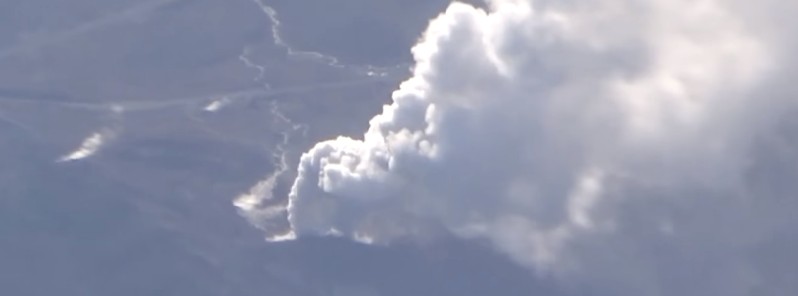Mount Io (Iwo-yama volcano) erupts for the first time since 1768, Japan

Iwo-yama volcano also known as Mount Io and Mount Ioyama, located on the Ebino Highland and a part of Kirishimayama volcano group in Japan's Kyushu, erupted at 06:39 UTC (15:39 JST) on April 19, 2018 for the first time since 1768.
The volcano ejected ash high into the air, forcing the Japan Meteorological Agency (JMA) to raise the alert level from 2 to 3 (of 5), restricting access to the volcano. Today marks the first time JMA has raised the alert level to 3 for this volcano.
The agency said that it confirmed the scattering of volcanic rocks around the crater and added that it is possible that the volcanic activity will further increase.
Residents and tourists are cautioned against falling rocks within 3 km (1.8 km) and pyroclastic flows within 2 km (1.2 miles) from the crater. In addition, the agency called for people to be on guard over the possibility of mudslides after any rainfall, depending on how much ash fell from the volcano.
The last time this volcano erupted was in 1768, exactly 250 years ago, according to the JMA's Fukuoka Regional Headquarters.
JMA raised the alert level to 1 on February 28, 2016, following an increase in shallow volcanic earthquakes. The alert was raised to 2 on February 20, 2018.
This is just the latest in a series of volcanic eruptions in the Kirishima mountain range. Mount Shinmoedake erupted in October 2017 for the first time in six years and has been active since with occasional eruptions.
霧島連山 硫黄山で噴火 警戒レベル3に引き上げ
4月19日午後3時半過ぎ(※動画早送りしています)https://t.co/4YjTeQsiPK pic.twitter.com/UcWXLPqpeR— NHKニュース (@nhk_news) April 19, 2018


2 live video streams are available at this time:




Geological summary
Kirishimayama is a large group of more than 20 Quaternary volcanoes located north of Kagoshima Bay. The late-Pleistocene to Holocene dominantly andesitic group consists of stratovolcanoes, pyroclastic cones, maars, and underlying shield volcanoes located over an area of 20 x 30 km (12.4 x 18.6 miles).
The larger stratovolcanoes are scattered throughout the field, with the centrally located, 1700-m-high (5 577 feet) Karakunidake being the highest.
Onamiike and Miike, the two largest maars, are located SW of Karakunidake and at its far eastern end, respectively.
Holocene eruptions have been concentrated along an E-W line of vents from Miike to Ohachi, and at Shinmoedake to the NE. Frequent small-to-moderate explosive eruptions have been recorded since the 8th century. (GVP)
Featured image: Mount Io (Iwo-Yama) erupting for the first time in 250 years on April 19, 2018, Japan. Credit: Kyodo

Commenting rules and guidelines
We value the thoughts and opinions of our readers and welcome healthy discussions on our website. In order to maintain a respectful and positive community, we ask that all commenters follow these rules:
We reserve the right to remove any comments that violate these rules. By commenting on our website, you agree to abide by these guidelines. Thank you for helping to create a positive and welcoming environment for all.